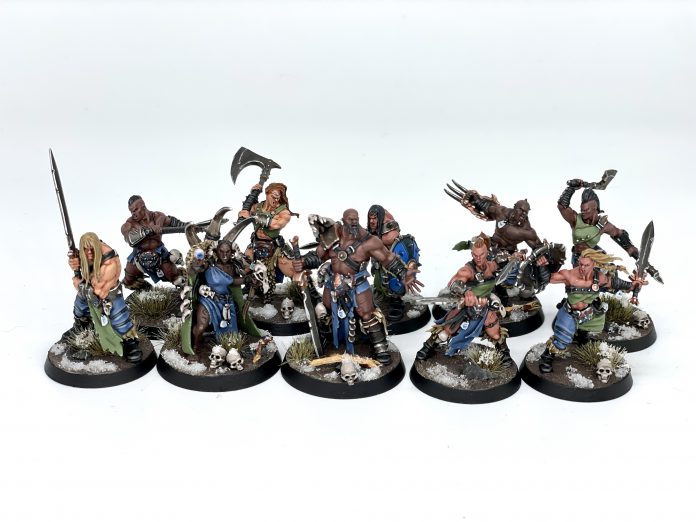What do you think of when you hear “Warcry?” With a small model count and myriad one-box entry points, it’s certainly one of GW’s most accessible games. Combine this with the wide array of narrative materials with the random battle generators in the core book, and it’s clear that our good buddy James Workshop has positioned Warcry as the ultimate casual game. Short on time? Paint these five Gorgers, roll these four dice, and if the game ends super quick, re-rack and play another! It’s a funny thing though – because to enable this feeling of lightness, of easy drink & pretzels gaming, GW wisely chose to drape the whole game onto what might be the simplest, cleanest rules chassis they’ve ever produced.
Like any good & simple ruleset, Warcry is easy to learn, easy to play while distracted, but devilishly difficult to play well. Therein lies the beauty of the game, and the reason Warcry holds up so shockingly well to competitive play. In this article (and future ones, I hope!) I’ll endeavor to give you the tools to understand the growing competitive scene in Warcry, to figure out how the game changes when both players bend their minds towards winning, and most importantly, to see the most fun path for you personally to jump into this awesome game.
Framing the Rules of Engagement
Let’s start by simplifying things to the barest bones: Warcry is unique, or at least rare among GW games, in that different battleplans have vastly different win conditions. This is part of the game’s casual DNA, an attempt to prevent there being anything obvious to build towards, but in practice it’s a huge part of what makes the game so compelling competitively. How do I arrange the 1500+ game pieces into a list that can accomplish such contradictory goals?
Unlike many of the randomized core book scenarios, matched play battleplans are about scoring points, and while every single mission will have a different way of doing so, it all boils down to doing these 3 things in some combination:
- Stand on things (Usually but not always objectives)
- Destroy things (Almost always your opponent’s fighters)
- Hold things (Usually treasures)
That’s it. Nice and simple. The cool thing is that it’s quite difficult to create a list that does all three (or even just two) of these things well. At the risk of sounding reductive, these three bullets above mean there are essentially three ways to win a Warcry game:
1. Win The Numbers Game
You simply stand more people on more things than your opponent. If you won this way, it’s because you either overwhelmed your opponent’s killing power, whittled your opponent’s numbers, or you blocked them from moving to the spots they wanted to stand on.
2. Do The Most Damage
Almost as simple as it sounds, but there is a tension here between the ability to put a lot of damage onto one model and the ability to spread that damage onto a lot of targets.
3. Win The Race, Then Win One Fight
Not every fight on the board is worth the same number of points, especially in treasure scenarios. If you have excellent power projection, or good interference pieces, you can make sure you win the one fight on the board that matters, even if you get massacred everywhere else.
If that’s too abstract, here are 3 battleplans that lean heavily towards one of those three directions. These are good intro examples – but know that most missions try to blend two out of three, since having multiple things to think about is fun. Note that only one of these is from the Warcry Core Book. It’s rare that you will go to a Warcry tournament anywhere in the world outside of Nottingham and play more than one GW-created mission out of four. The story of why the community took matters into their own hands is long enough that it’ll have to get its own article one day. It appears GW is listening, as they’ve very recently (as in the last two days) begun releasing battleplans that look much like iterations on what the community has been creating.
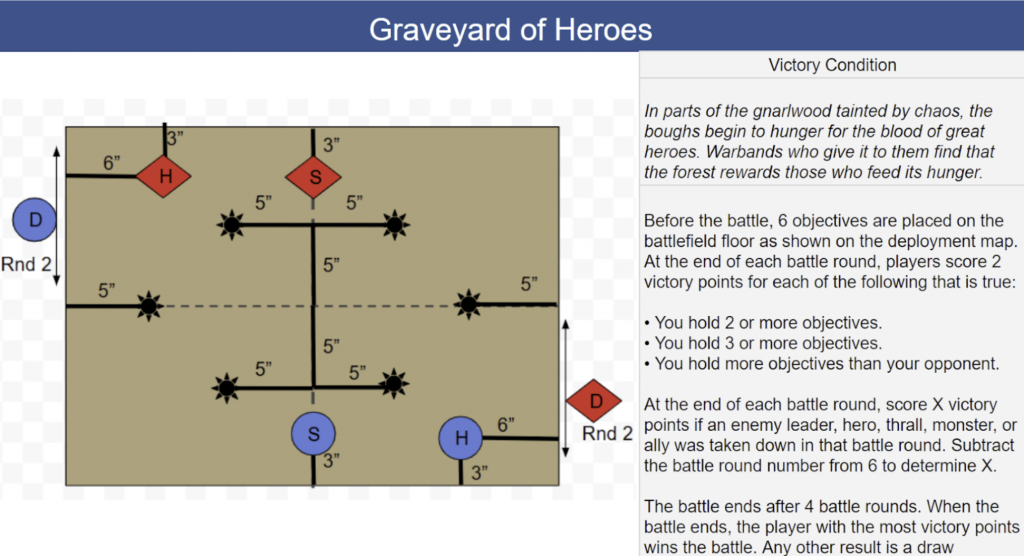

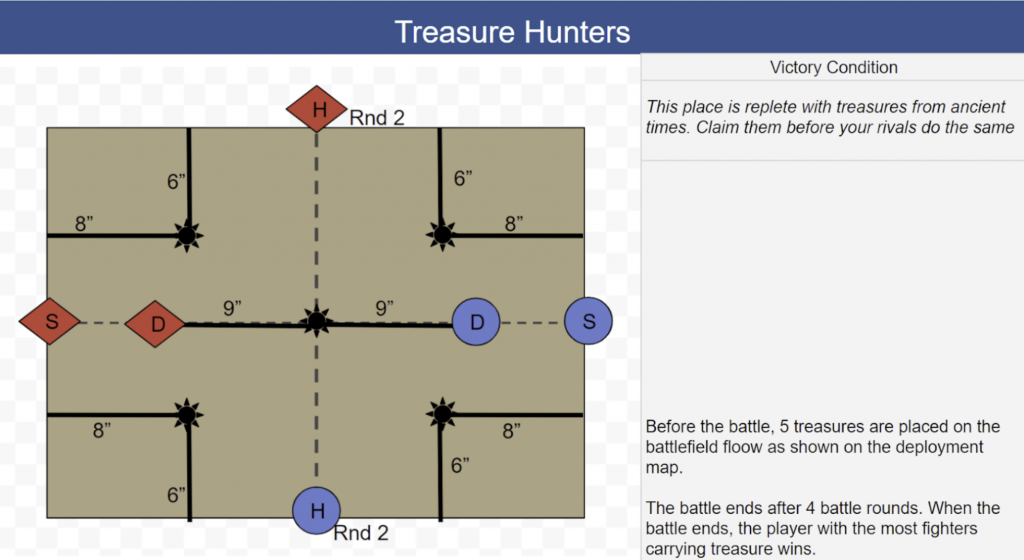
Framing the Tools at Your Disposal
So I promise I’ll get into the nitty gritty soon, but there’s still a couple more important fundamentals to unpack. If you’ve played Warcry before, you’ll know that there are two core game mechanics that dictate the run of play more than any other.
- Activations
- Dice Abilities
Every single fighter has 2 actions in an activation. Players alternate using them, which means the rhythm of the game is entirely dictated by presence of activations, and the complex sequencing behind when and where you use them. As a result, even a fighter with only 1 wound, no attacks, and 1” of movement would have some value in most battleplans, since you could use the activations to score points, manipulate the rhythm or tempo of a game, and/or just generally make a nuisance of yourself.
Abilities can be many things, but they come from your opening initiative roll, and generally fall into the categories of flat-rate effects, disruption, and force multipliers. For the force multiplier abilities, the bigger the fighter being buffed the more value you get. 20% of 100 is much bigger than 20% of 10, after all. For the other abilities, the cheaper the fighter can be while still surviving to use their ability in the late game, the better off you are.
You can combine these two things and get to the idea that the two most important things a fighter can give you are:
- Action Economy
- Total Output
Fortunately, these are often very much at odds, but the strongest competitive approaches to the game depend on finding ways to make them go hand-in-hand. Does this mean we get to leave the super basics and get into the actual powerful stuff in Warcry? Yes it does!
Using the Actual Tools at Your Disposal
Let’s keep the structure of previous sections, and go into some of the best fighters at achieving the various ways to win in Warcry. I listed three above, so I’ll have three overarching sections here.
Fighters and Abilities that Excel at Winning the Objective Game:
There are quite a few ways to win the objective battle, but here are some of the fighters and abilities that have proven most consistently excellent over time.
- Durable bodies: The best way to win an objective over 4 rounds is to put a bunch of fighters on it, and have them stay alive a surprisingly long time. So cheap, defensive fighters are excellent here. At the moment, it’s probable that the best fighters at purely filling this role are the Plaguebearer, the Skeleton Warrior, and the Mortek Guard.
- Cheap archers: Another excellent way to secure an objective is fighters who can stand on one objective while taking potshots at the poor chaff on a nearby objective. It’s one of the most efficient uses of turning activations into points scored, and so GW has rightly raised the points on the vast majority of small archers. Luckily for folks who enjoy this playstyle, our friend James forgot a few, and both Kharadron Arkanauts and Huanchi’s Claws from Hunters of Huanchi can be quite dominant when positioned correctly.
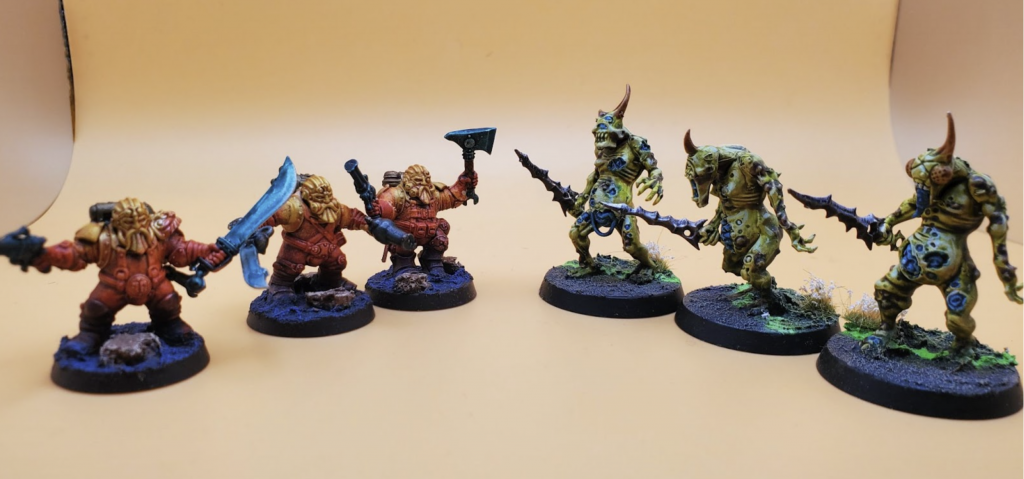
- Abilities that secure objectives: Right now, there are two abilities that get to simply cheat the objective math. They are You Messin, which is available to Ironjawz Brutes, and Over My Dead Body, which is available to all Dispossessed. As a result, Brute bosses and Dispossessed leaders such as Warden Kings and Runelords are some of the best allies in the game.
- Abilities that can clear multiple small fighters at once: There are a few AOE damage effects in the game, but by far the best is Engulfing Flames of Dark Artifice, which is available to Horns of Hashut Flamehurlers. There are also a few factions in the game with the ability to gain a bonus action after slaying an enemy fighter, which lets you chain attacks and hopefully destroy multiple little grunts at once. Of the factions with access to these types of abilities, Ogor Mawtribes are by far the best at using them, because they have the best damage output for securing the trigger on the ability.
- Abilities that protect your fighters: The vast majority of the damage reduction abilities in the game are on fighters who are so inefficient for their points that they can’t be used competitively, but there are some exceptions. Horns of Hashut have a notable exception in Ash Bomb, an ability that gives opponents -1 Toughness and -1 Attack, and is an aura attached to a token, so can’t be canceled by taking out the fighter who put it there.

Fighters and Abilities that Can Win the Damage Game
As I briefly mentioned before, there are two different types of damage you need to be able to do in Warcry. You will occasionally have to put big, big damage onto opposing heroes to burst them down, and you’ll occasionally have to hunt down and take out chaff models repeatedly across the board. Only a few fighters are truly excellent at both.
Chaff hunters are an incredibly important part of the Warcry metagame. One of the most powerful things you can do is take down an opposing fighter with a single activation, and so taking fighters who can pass a number of damage checks (preferably from a long way away) is quite valuable. Some of the most important defensive profiles to be able to clear are T3 8w (elves), T4 10w (Plaguebearers and most humans), T3 12w (Dwarves), and T4 15w (Orruk). Likely the best fighters at clearing these hurdles from a long way away are the Akhelian King, the Varanguard, and Thunderers with Aethercannon or Grundstok Mortar. The King and the Varanguard have Storm of Blows and Relentless Killers, which are functionally identical Doubles that can let you 1-shot chaff models at a very high percentage. KO Thunderers simply have excellent ranged damage, and their leaders have access to Fight for Profit which is an AOE ranged buff that boosts Thunderer damage into the stratosphere.
While those three fighters are amazing, there is also a set of factions with movement burst abilities on high damage fighters that let you put chaff-killing damage out at a surprising range. Slaangor Slakehorns with Slaves to Impulse, Ossiarch Stalkers with Hunt and Kill, and Ogor Leaders with On the Mawpath are some real standouts here.
When you aren’t hunting chaff, you’re looking to duel the opposing elites (or threaten the ability to). That requires a very different set of skills. The aforementioned Akhelian King and Varanguard are actually quite poor here, given their points costs. Instead, you need high strength to ensure you still hit on 3s or 4s against the higher toughness opponents, and you want some durability of your own, since there’s a great chance you’ll take a hit back after you engage.
Fomoroid Crushers are excellent here, as are Skaven Stormfiends and Stormcast paladins such as the Annihilator Prime, but the real master of the art form is the humble Brewgit. Using the ability Loonshine Potion, it can give bonus attacks to the high-strength, high-damage profiles of the best smash pieces in the game. With the brewgit nearby, Ironjawz Megabosses, Ogor Tyrants & Gutlords, and Gorger Mawpack Clawbacks become absolute earthquakes capable of one-shotting opposing heroes with even fairly pedestrian rolls.

Fighters and Abilities that Can Win the Holding Game
Treasures are a funny part of the game; many of the early treasure missions in Warcry were awful to play competitively, insofar as going first in round one mattered far too much. GW has put some good work into finding solutions here, and the community has run with it. You will often see treasures incorporated as a secondary objective in other types of battleplans, and they work excellently in that role.
Winning the treasure battle involves two steps: Winning the race to the treasure, then either absconding with it or just surviving until the end of the game. If you lose the race, you need ways to both stop your opponent from running away, and damage output to take out their treasure carriers. Probably the two best fighters in the game at doing this dance are the Bloodwrack Medusa and the Mindstealer Sphiranx. Both are fast, durable, have reasonable damage output, and most importantly, both have a “net” ability. Bloodwrack Stare and Telepathic Threatening both have the ability to prevent a fighter from making move or disengage actions for the rest of the round, so you can both lock an opposing treasure carrier in place, or you can stop a scary hammer piece from chasing you down.

There’s more than one way to skin a cat though, and a number of other approaches can be quite successful in these types of missions.
- Artillery pieces are wonderful to have, since they can take out an opposing treasure carrier even after it’s run away, so KO Thunderers, Hrothgorn Mantrapper (the Underworlds Icebrow Hunter), and even things like Tzeentch flamers or Kruleboyz Boltboy Bosses are quite nice to have.
- Horde fighters can be surprisingly useful in treasure missions. Each individual chaff model might be quite bad at carrying treasure or taking out a treasure carrier, but the additional activations mean that when you do get taken out, you have another buddy nearby to go pick it up, and the expendable bodies mean you can go run interference. Having a chaff model run up to an opposing threat and pin it in combat means it will have to either waste an action or two taking out your chaff, or spend an action on a disengage. Either way it likely won’t be taking out your treasure carrier this turn.
- Finally, big old elite duelists, which many in the community nickname “titans,” can be quite good here. They may not be the fastest, but once they have a treasure, good night. All the Fomoroid Crushers and Ogor leaders that I mentioned before are quite durable, but they also have this extra layer of defense called “offense.” Their damage output is so overwhelming that any fighter who runs up to take them out will often get deleted before it can get a second wave of attacks in.
Putting It All Together
So I’ve outlined the ways to win, and some of the fighters and strategies that are very good at fulfilling those victory conditions; combining them into functional warbands, however, can be daunting. The goals are so often at cross-purposes that there is quite a bit of innovation still occurring in the scene, especially around the nine new factions that entered the game late last fall. The specific missions you expect to play in an upcoming tournament pack are hugely influential to what makes the “correct” list for an event. For a deep dive into this section, you can take a look at a video I made on the subject, here:
But for a quicker outline, here are some strategies that have been successful time and time again.
Khharadron Overlords (“MedusaCannons”)
There are a lot of potentially excellent approaches to Kharadron Overlords, but the dwarf enthusiasts have generally settled on Aethercannons and Bloodwrack Medusae as the threats of choice. Here’s a competitive list from Micah Mueller that he took to a tournament victory in Minnesota, USA.
Hammer
- Bloodwrack Medusa (275, Hero)
- Arkanaut Company Privateer with Privateer Pistol and Arkanaut Cutter (50)
- Arkanaut Company Privateer with Privateer Pistol and Arkanaut Cutter (50)
Dagger
- Company Captain (90, hero)
- Grundstock Thunderer w/ Aethercannon (110)
- Grundstock Thunderer w/ Aethercannon (110)
- Arkanaut Company Privateer with Skypike (75)
Shield
- Endrinmaster w/ Endrinharness (140, hero, leader)
- Arkanaut Company Privateer with Privateer Pistol and Arkanaut Cutter (50)
- Arkanaut Company Privateer with Privateer Pistol and Arkanaut Cutter (50)
The ability Fight For Profit is a combo with Aethercannons, in that they only have 1 attack, but it does 17,000 damage if it hits, so boosting it doubles and can even triple their damage (FFP occasionally gives +2 attacks), making it an excellent way to take out all kinds of fighters without getting your hands dirty. The bloodwrack medusa does everything that dwarves aren’t good at. She’s fast, she has good melee damage on low-toughness models, and she can control opposing movement with her ability. Finally, Arkanaut Company are just incredibly points efficient at standing on objectives and scoring points over time, while still putting out chip damage to anything that happens to wander nearby.
Nurgle Daemons (“Smalls and Talls”)
When getting stuck in to try and actually win a tournament, this has generally been my faction of choice. Plaguebearers are just very cheap, very points efficient, and very low maintenance from a dice perspective. That means that any big allies you bring into the faction will thrive, since they can monopolize all your dice abilities while benefiting from the tempo and sequencing advantage that Plaguebearers provide. I’ve won three tourneys now with this faction, and while my approach is slightly different, most folks have settled on an equally successful Nurgle approach that often looks like the following list from Christian Gesso, who piloted it to a tournament victory in Coppenhagen.
Hammer:
- Plagueridden (90, Leader)
- Plaguebearer (50)
- Plaguebearer (50)
Dagger:
- Enlightened Aviarch on Disc (275, Hero)
- Plaguebearer (50)
- Plaguebearer (50)
Shield:
- Varanguard with Daemon Forged Blade (285, Hero)
- Plaguebearer (50)
- Plaguebearer (50)
- Plaguebearer (50)
This warband utilizes a horde of slow, durable chaff alongside two fast, scary hammers, that each have the disadvantage of being quite dice-hungry. Varanguards need Relentless Killers, and Enlightened on Disc need Guided by the Past to be actual threats, but with how low maintenance the actual bodies in your warband are, you should usually have the flexibility to spend dice on the fast hammers.
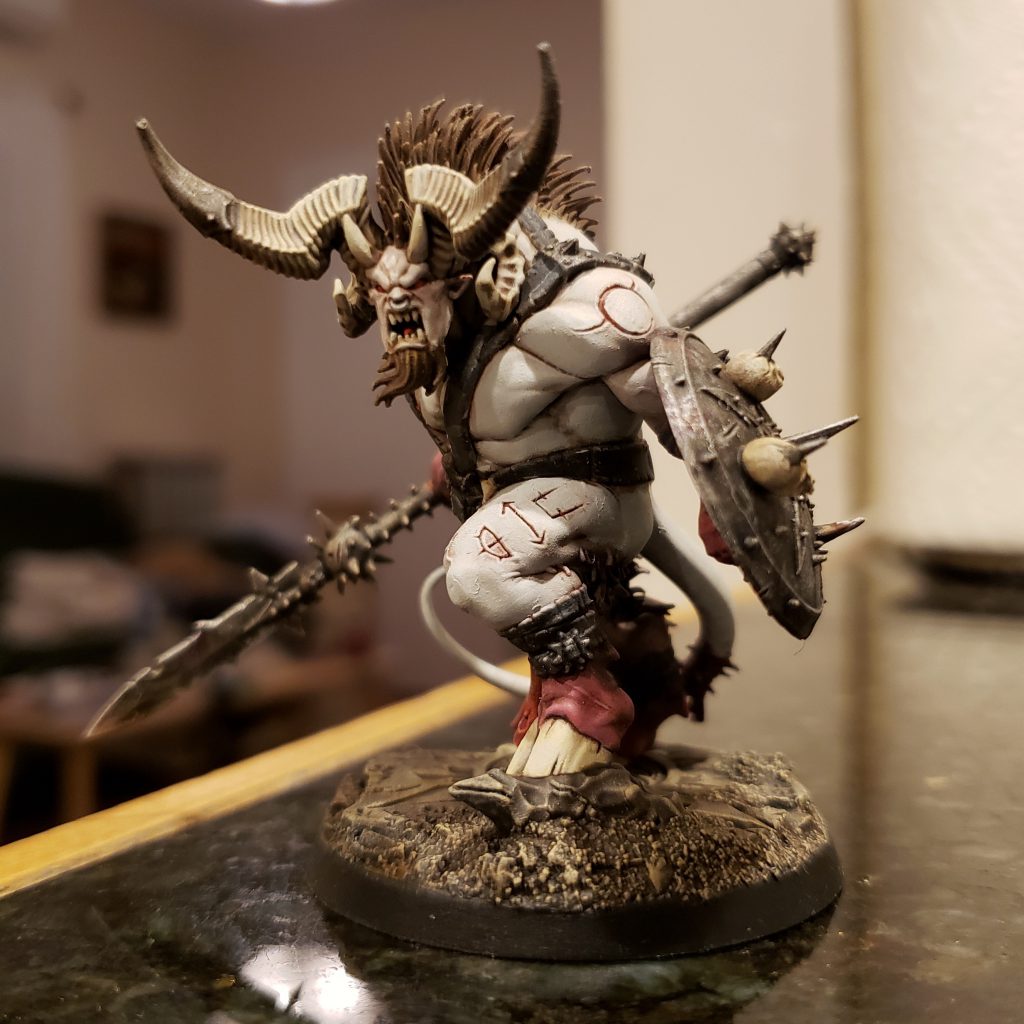
Horns of Hashut
There’s not much consensus on what the best Horns list is, but the one thing the community can agree on is that they absolutely slap. They have access to cheap bodies, can ally in a heavy hitter easily, and most importantly, they have access to some utterly game-breaking Triple abilities. Since it’s hard to find a single unified build, here’s a list that JJ Austrian plays that I’ve tested against quite a bit. He’s 5W-1L-2D with it in his last two events.
Hammer:
- Ruinator Alpha w Heavy Flail (165pts, Leader)
- Shatterer (55)
- Shatterer(55)
Dagger:
- Trueblood (175, Ally)
- Demolisher w Flamehurler (125)
- Shatterer (55)
Shield
- Ogroid Myrmidon (265, Ally)
- Shatterer (55)
- Shatterer (55)
One of the most common list archetypes in competitive Warcry is seeing a bespoke Chaos faction with an allied Fomoroid Crusher. This version of Horns has many of the strengths of those lists, but with an extra host of internal synergies. We’re trading in the usual Fomo Crusher for the very similar Ogroid Myrmidon due to the synergy between having a 100% spear warband alongside the Trueblood. The Trueblood is the leader of the Splintered Fang faction, and a very popular ally in Chaos due to its ability to freeze a model on a double without worrying about a 33% chance of failure the way most similar abilities do. It’s in the same deployment as the Demolisher w Flamehurler here, to protect the fragile archer so it can cast Flames of Dark Artifice. The Myrmidon’s 2” range allows it to smack a frozen model without fear of reprisal, which our five Shatterers with 2” reach can do as well. Finally we round out the list with a Ruinator Alpha, who is more than just a tax here with his ability to cast Ash Bomb, a triple that drops opposing toughness and attacks in a 3” radius, giving you a massive advantage on a single teamfight each round you use it.
Destruction Soup
An amorphous name for a large set of very similar strategies that take advantage of Destruction having slightly different ally rules than the rest of the Grand Alliances. One of the most famous names in Warcry is Peter Mercincavage, and he recently took Ogor Mawtribes to a win in New Jersey, USA. He won on tiebreakers after Robert Viscomi battled him to a draw in the finals. Robert was also piloting a very different version of Destruction soup. Here are both lists so you can get a sense for the diversity of the archetype.
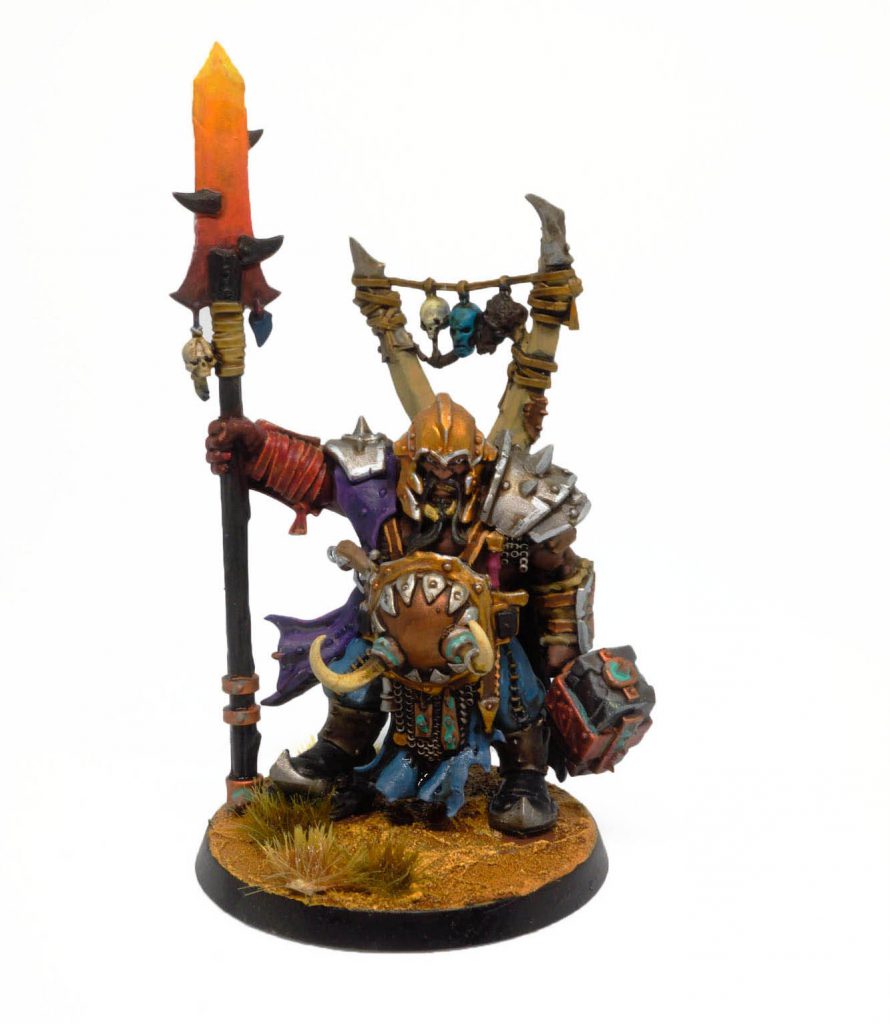
Hammer
- Ardboy Boss (135, Ally)
- Shank (55, Bladeborn Ally)
- 40 Bushwakka (40, Bladeborn)
Dagger
- Mannok da Kunnin (185, Bladeborn Ally)
- Torka Tuffskull (125, Bladeborn Ally)
- 45 Quiv (45, Bladeborn)
Shield
- Ogor Tyrant (315, Leader)
- Gikkit (55, Bladeborn Ally)
45 pts of Divine Blessings
Rob’s Ironjawz
I saved the most complicated for last. Did you check all the named characters in Peter’s list? Those are from underworlds, also called Bladeborn fighters in Warcry, which allow you to bend the ally rules to get more strange weirdos in your lists. He focused on the ability to “net” opposing threats, with both Shank and Torka Tuffskull having the ability to shut off moves and disengages. He also used a mechanic called divine blessings to spend points to add stats to his fighters, which allowed him to push his damage into silly territory on the Tyrant without needing a Brewgit, but could be used judiciously to turn Mannok da Cunnin or the Ardboy Boss into more powerful threats if needed.
Hammer
- Clawback (235, Hero) (H)
- Brewgit (70, Ally)
Dagger
- Orruk Brute with pair of Brute Choppas (140)
- Orruk Ardboy with Ardboy Choppa and Orruk-forged Shield (80)
- Orruk Ardboy with Ardboy Choppa and Orruk-forged Shield (80pt)
Shield
- Orruk Megaboss (225, Hero)
- Orruk Ardboy with Ardboy Choppa and Orruk-forged Shield (80)
- Orruk Ardboy with Ardboy Choppa and Orruk-forged Shield (80)
Robert’s version is more straightforward to look at, but equally difficult to pilot. He ran the normally slow Ironjawz, but by including the Clawback as an ally, he ensured that every single fighter in his warband other than the Brewgit had the ability to spend a double to gain a bonus move action if within 6” of an enemy. He also included a Brute, which could use You Messin to negate enemy chaff models. Between You Messin, Charge, Waagh, and Loonshine Potion, this warband requires you to make careful choices on how to spend your dice, but rewards you handsomely when you get it right.
It would be impossible to go over everything – as at least half of the factions in the game are capable of winning a large tournament in any given weekend – but hopefully I’ve given you what you need to feel like you’ve got your bearings once you decide to dip your toe in the water. The game is exciting, and the competitive side is growing. Hopefully we see you out there. Want us to take a look at a particular warband? Drop us a line at Contact@Goonhammer.com.
If you liked this article, check out Dan’s Youtube channel The Salty Sea for more Warcry tips and discussion.
